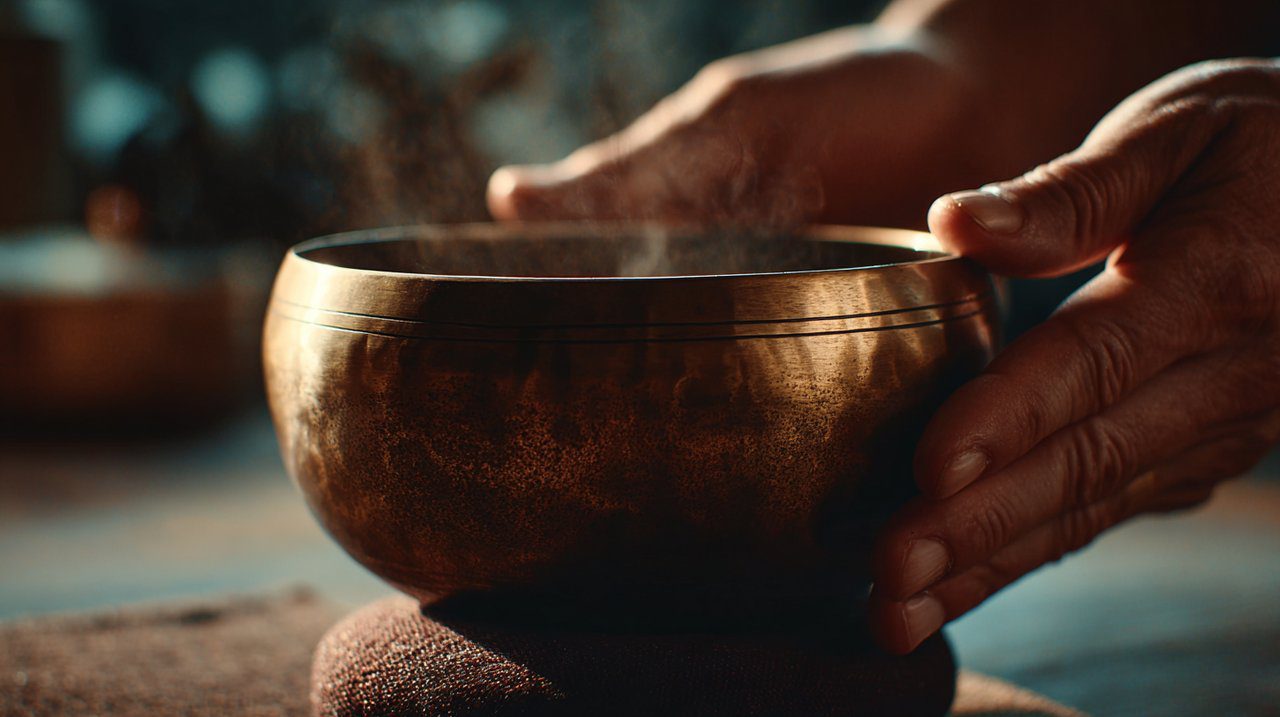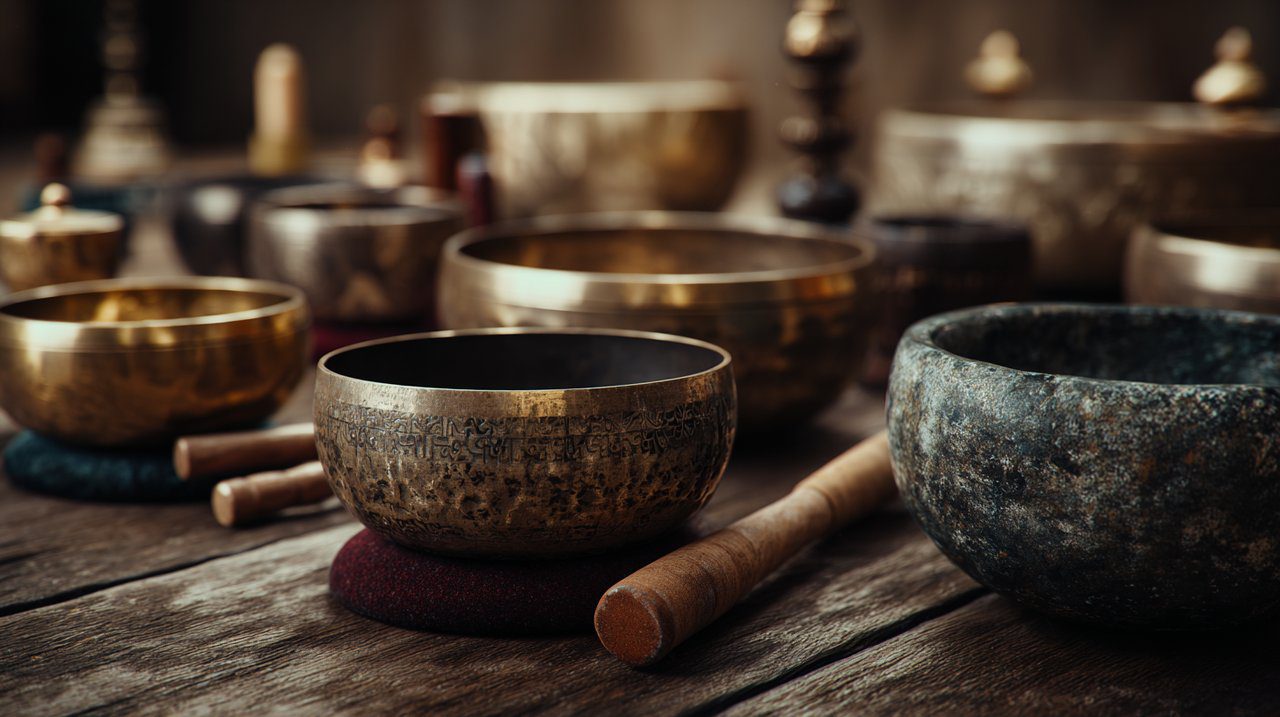Buddhist Bowl Bell: The Ultimate Guide to Choosing & Using for Meditation & Healing
A quiet longing for stillness and clarity often arises within the rhythm of our lives. Many seek genuine support for cultivating focus and inner peace. A buddhist bowl bell offers a unique path, transforming from a simple object into a trusted companion. Through careful, mindful engagement, it becomes a personal tool for nurturing a deeper sense of inner well-being and integrating mindfulness techniques into daily life. Like the focused repetition of counting mala beads, the bowl bell guides us to a centered awareness.
The Sacred Pause: Cultivating Stillness
A buddhist bowl bell extends beyond mere sound; it offers an invitation to a sacred pause. This is a moment we intentionally create, connecting with the vibrations and allowing them to gently anchor our awareness, offering a palpable sense of stress relief.
From my own practice, I’ve observed that infusing each strike or rim with a clear intention transforms the bowl bell from a simple object into a quiet guide for inner connection. Imagine the difference: striking the bowl without a thought versus doing so with the clear intention to center yourself, to release a little tension, or to invite a sense of peace. The shift is palpable.
That conscious intention reshapes the entire experience. The sound resonates differently, not only in the air but deep within your own being, fostering a truly meaningful connection.
"The space between thoughts is the doorway to wisdom."
When we consciously cultivate that space through sound, we gently open ourselves to deeper understanding and quiet insight. Take a moment now: strike your bowl with a gentle intention, and simply observe how that focus shifts your listening.

Understanding Your Bowl Bell: Materials, Craft, and Voice
To truly connect with a buddhist bowl bell, it helps to understand its very essence: the materials, its creation, and its unique voice. These elements profoundly shape the instrument that will become your resonant companion.
Composition and Resonance
Traditional bowls often feature blends of metals, typically bronze (an alloy of copper and tin), or special multi-metal compositions with up to seven different kinds, sometimes including silver, gold, iron, and lead. Each blend contributes to a bowl’s distinct character and lasting quality. The specific composition subtly influences the spectrum of overtones—those shimmering, secondary tones that give a bowl its unique depth—and the intricate vibrational patterns you will feel.
For example, a higher copper content might lend warmth, while tin can enhance sustain. The ancient wisdom of Tibetan singing bowl history guided these nuanced material choices, seeking harmony not just in sound, but in energetic response. This tradition is a testament to the meticulous care in crafting spiritual tools, much like the precision found in creating dzi beads for their protective qualities.
The Art of Creation
The crafting method, whether cast into a mold or carefully hand-hammered from a flat sheet, further refines these vibrational patterns. Hand-hammering, often involving multiple artisans and repeated heating and cooling, creates unique imperfections that contribute to a bowl’s complex harmonic profile and rich, layered sound. This intricate process speaks to the dedication behind each instrument.
This is why it is so important to personally connect with a bowl before making your selection. From my own experience, a hasty choice often leads to a bowl that doesn’t quite align with one’s inner needs, underscoring the value of a mindful approach.
Listening to Its Voice
Take a moment with each potential bowl: touch its surface, feel its texture, and listen closely to its sound. This direct, sensory experience allows you to feel the vibrations in your hands and hear the beauty of its sustained tones and gentle echoes. This mindful interaction is a core element of mindfulness techniques in itself.
You might observe that traditional Tibetan singing bowls often offer deep, grounding tones, like the steady pulse of the earth. In contrast, smaller, modern sound bowls might have lighter, clearer pitches that feel uplifting, like a gentle breeze. Remember, a louder sound is not necessarily a better one. Instead, listen for the purity and layered richness of sound, how the notes intertwine and sustain.
A truly resonant bowl will offer a clear, sustained tone with gentle overtones, regardless of its size or volume. It is about how its unique voice speaks to you, inviting a sense of calm and presence.

Finding Your Resonance: Choosing a Bowl Bell
Choosing a buddhist bowl bell is a deeply personal experience, guided by your meditation style, what you hope to cultivate, and your intuitive feeling. It is about finding an instrument that truly feels like an extension of your inner world, rather than merely something visually appealing.
Remember this essential principle: how it feels to you holds far greater significance than its appearance to others. To discover your true match, dedicate a mindful moment to each bowl you consider. Avoid the common pitfall of selecting based solely on aesthetics; its authentic value resides in its vibrational connection and how it resonates with your inner landscape.
Close your eyes, gently strike or rim the bowl, and simply notice. How do the vibrations settle within your body and mind? Do they invite a sense of calm, a gentle energy, or a clear focus? This intuitive listening is an integral part of the process, guiding your discernment among various Tibetan singing bowl types.
For instance, if you seek grounding, you might be drawn to a bowl with a deep, earthy tone that resonates with your lower body, much like a steady foundation. This deep resonance can be akin to the stable energy offered by root chakra stones. If mental clarity or emotional release is your intention, you might prefer a higher, lighter sound that lifts your spirit. When working with specific energy centers, you may even consider chakra singing bowls designed to align with particular frequencies. Always trust your inner response, as it is your most reliable guide.
The Gentle Invitation: Learning to Play Your Bowl Bell
Playing a buddhist bowl bell is truly an art of gentle invitation. With patience, a soft touch, and an open ear, you can awaken its full, beautiful sound, allowing its voice to unfold.
The journey begins with simply learning how to cradle the bowl and hold the mallet, then gently producing sound by striking or circling its rim. This very process, from the first hesitant tap to a sustained hum, becomes a quiet practice in mindfulness techniques.
When striking, hold the mallet with a loose, relaxed grip. Gently tap the bowl’s outside, allowing the sound to blossom and grow naturally. For rimming, hold the bowl steady in your palm and move the mallet slowly around the outer edge with even, soft pressure. A common observation is that applying too much pressure can stifle the bowl’s true voice, creating a strained rather than a resonant tone.
Lightness and fluidity are the true keys. Excessive force or a tight grip can prevent the bowl from singing its natural, clear tone, often leading to harsh or uneven sounds. Consider this: the way we coax forth sound from the buddhist bowl bell often mirrors our own search for inner peace. It gently reminds us that true harmony emerges not from force, but from a delicate balance of clear intention and the grace of letting go.
Beyond the Cushion: Integrating Bowl Bells into Daily Life
Your buddhist bowl bell is not reserved solely for formal meditation. Its resonant voice can gently weave moments of mindfulness throughout your entire day, creating micro-rituals that deepen your presence and focus.
These brief, intentional engagements act as soft reminders to pause, take a breath, and return to the present moment. They transform ordinary activities into quiet opportunities for awareness, serving as effective self-care practices that nourish the spirit.
Consider striking your buddhist bowl bell once before you begin a new task, signaling a gentle shift in focus. Or use it at the end of your workday to mindfully release any accumulated tension. This intentional use is much like the focused repetition in mantra chanting, offering a tangible anchor for your mental state. For those interested in exploring how other mindful tools can enhance daily practice, understanding the role of prayer beads can offer a complementary path to intentional living. Rose Quartz Prayer Beads: A Guide to Cultivating Love, Compassion & Emotional Healing
Imagine a moment of unexpected stress: a soft tap on your bowl can become an immediate ‘pause button.’ It invites you to simply breathe and re-center yourself before reacting. These daily ‘sacred pauses’ are powerful. They help us step away from autopilot and gently cultivate a continuous thread of awareness, guiding us back to the natural rhythm of our own lives. Just as a red agate stone can offer a sense of stability, the bowl bell provides a resonant anchor.
Sound as Sanctuary: Healing Vibrations
The deep vibrations of a buddhist bowl bell offer more than just beautiful sound; they provide a gentle, accessible path to inner calm and deep relaxation. These resonant frequencies subtly interact with our bodies, influencing our sense of serenity, our brainwave states, and our various energy centers, making singing bowls wonderful companions for personal sound therapy practices.
Modern acoustic research explores how these vibrations can softly rebalance our inner energies. From a personal perspective, I find that the sustained tones gently guide my mind away from the incessant chatter of daily thoughts. This natural shift can encourage brainwave patterns associated with deep relaxation, such as alpha and theta waves, inviting a state of peaceful receptivity for deep meditation. Early studies, for instance, have explored how specific sound frequencies can influence brain activity and promote relaxation, suggesting a physiological basis for the perceived calm.
Just as healing crystals are often used to align chakras, the sounds of a bowl bell can gently shift our inner landscape, fostering a sense of spiritual awakening, much like the intentional wearing of sacred adornments for personal energy practice. スピリチュアルブレスレットの真意:エネルギー実践のための完全ガイド A low, sustained tone, for example, can help you feel deeply grounded and stable, resonating with your lower body and bringing a lasting sense of security.
To experience this for yourself, try a simple sound bath. Lie down comfortably, perhaps with a soft blanket, and place mini sound bowls around your body (never directly on it unless guided by an expert). Allow the sustained vibrations to gently wash over you. This immersive experience can soothe your nervous system, ease tension, and invite deep, restorative sleep.

From the mindful moment you choose your buddhist bowl bell to your ongoing, gentle engagement with it, you are cultivating a path of transformation and deep connection. Through intentional interaction, this simple object can become a quiet mirror for self-discovery, inviting lasting peace and clarity into your life.
This journey offers a gentle, lasting partnership with a source of tranquility and healing. With this deeper understanding, you may feel ready to choose your first bowl bell, or to deepen the connection with one you already have. Allow its gentle vibrations to guide you toward a more present, peaceful way of being.
💡 よくある質問
Striking a Buddhist bowl bell with a clear intention, such as centering yourself or releasing tension, transforms it from a simple object into a guide for inner connection. This conscious intention causes the sound to resonate differently, creating a more meaningful experience and opening a 'sacred pause' between thoughts, which leads to deeper understanding and insight.
When choosing a Buddhist bowl bell, consider the materials (like traditional brass or multi-metal blends) and the crafting method (cast or hand-hammered), as these influence its unique voice and quality. It's crucial to connect personally with the bowl by touching its surface and listening to its sustained tones and gentle overtones to ensure its sound resonates with you, rather than focusing solely on volume.
Playing a Buddhist bowl bell requires a gentle invitation. Hold the mallet loosely and gently tap the bowl's outside for striking, allowing the sound to grow naturally. For rimming, hold the bowl steady and move the mallet slowly around the outer edge with even, soft pressure. Lightness and fluidity are key; too much force can create harsh sounds.
Buddhist bowl bells can be used throughout the day to create micro-rituals of mindfulness. You can strike the bowl before starting a new task to signal a shift in focus, use it at the end of the workday to release tension, or tap it during unexpected stress as an immediate 'pause button' to breathe and re-center yourself, cultivating a continuous thread of awareness.
The deep vibrations of a Buddhist bowl bell offer healing and deep relaxation by interacting with the body's resonant frequencies. These vibrations can rebalance inner energies, influence brainwave states, and soothe the nervous system. For instance, a low, sustained tone can promote grounding and security, making sound baths with bowl bells a powerful tool for easing tension and inviting restorative sleep.








